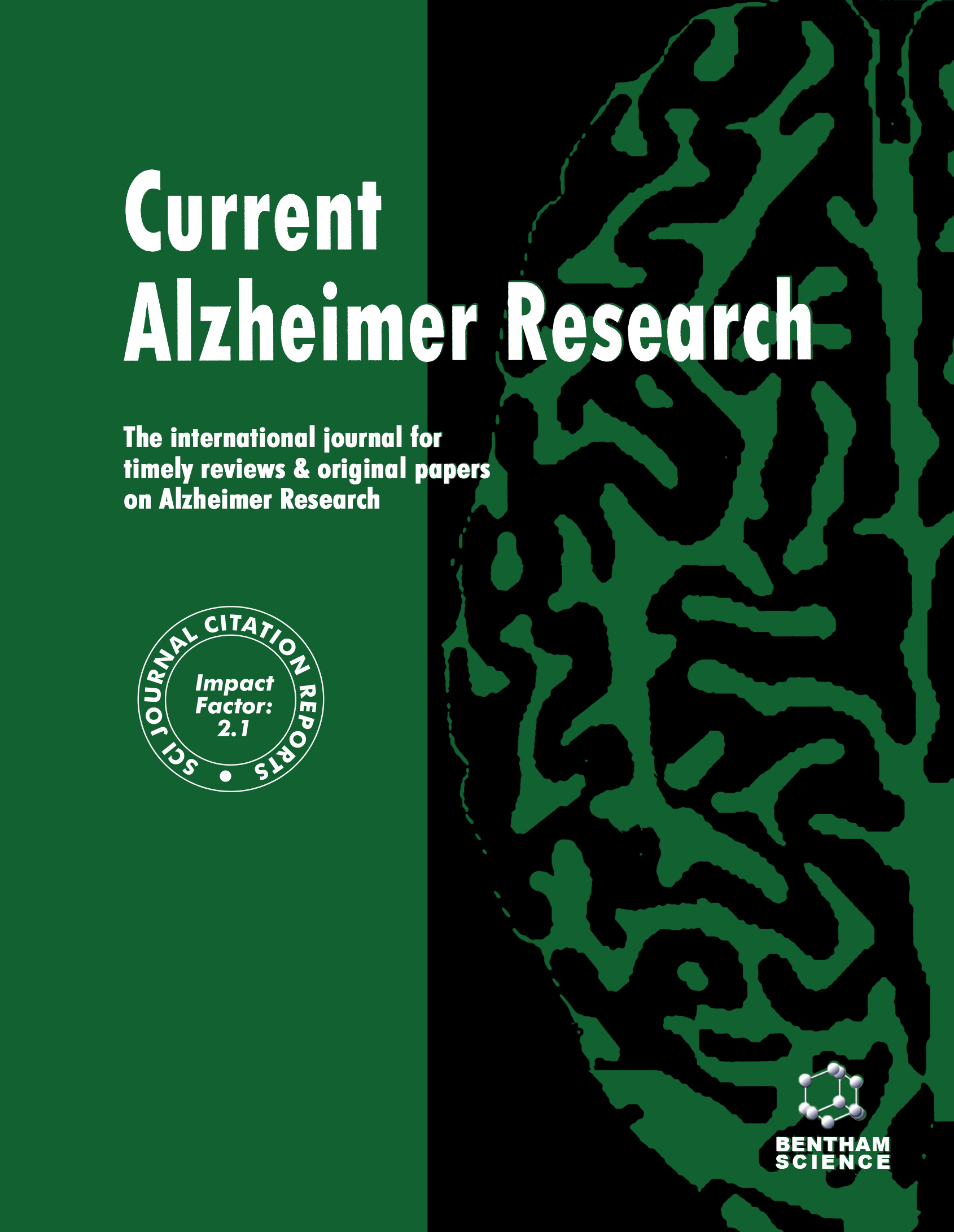- Home
- A-Z Publications
- Current Alzheimer Research
- Previous Issues
- Volume 17, Issue 1, 2020
Current Alzheimer Research - Volume 17, Issue 1, 2020
Volume 17, Issue 1, 2020
-
-
A Protective Role of Translocator Protein in Alzheimer’s Disease Brain
More LessTranslocator Protein (18 kDa) (TSPO) is a mitochondrial protein that locates cytosol cholesterol to mitochondrial membranes to begin the synthesis of steroids including neurotrophic neurosteroids. TSPO is abundantly present in glial cells that support neurons and respond to neuroinflammation. Located at the outer membrane of mitochondria, TSPO regulates the opening of mitochondrial permeability transition pore (mPTP) that Read More
-
-
-
Depression in Dementia or Dementia in Depression? Systematic Review of Studies and Hypotheses
More LessThe majority of research works to date suggest that Major Depressive Disorder (MDD) is a risk factor for dementia and may predispose to cognitive decline in both early and late onset variants. The presence of depression may not, however, reflect the cause, rather, an effect: it may be a response to cognitive impairment or alters the threshold at which cognitive impairment might manifest or be detected. An alternative h Read More
-
-
-
Microglia in Alzheimer’s Disease
More LessAuthors: Patrick Süß and Johannes C.M. SchlachetzkiAlzheimer’s Disease (AD) is the most frequent neurodegenerative disorder. Although proteinaceous aggregates of extracellular Amyloid-β (Aβ) and intracellular hyperphosphorylated microtubule- associated tau have long been identified as characteristic neuropathological hallmarks of AD, a disease- modifying therapy against these targets has not been successful. An emerging concept is that microglia, the innate immune cel Read More
-
-
-
Ampelopsin Improves Cognitive Impairment in Alzheimer’s Disease and Effects of Inflammatory Cytokines and Oxidative Stress in the Hippocampus
More LessAuthors: Yan Wang, Wei Lv, Yueyang Li, Dandan Liu, Xiuting He and Ting LiuBackground: Neuroinflammation and oxidative stress have significant effects on cognitive deficiency in the pathophysiological development of Alzheimer’s disease (AD). In the present study, we studied the influences of Ampelopsin (AMP) on proinflammatory cytokines (PICs, IL-1β, IL-6 and TNF-α), and products of oxidative stress 8-isoprostaglandin F2α (8-iso PGF2α, a product of oxidative stress); and 8-hydroxy-2’-deoxygua Read More
-
-
-
Amyloid β-induced Mesenteric Inflammation in an Alzheimer’s Disease Transgenic Mouse Model
More LessAuthors: Yasuhisa Ano, Kumiko Ikado, Kazuyuki Uchida and Hiroyuki NakayamaBackground: Alzheimer’s disease (AD) is a neurodegenerative disorder histopathologically characterized by the accumulation of amyloid β (Aβ) peptides and inflammation associated with activated microglia. These features are well investigated in the central nervous system using AD-model mice; however, peripheral inflammation in these mice has not been investigated well. Objective: We evaluated the inflammatory respon Read More
-
-
-
Automatic Detection of Cognitive Impairments through Acoustic Analysis of Speech
More LessBackground: Early detection of mild cognitive impairment is crucial in the prevention of Alzheimer’s disease. The aim of the present study was to identify whether acoustic features can help differentiate older, independent community-dwelling individuals with cognitive impairment from healthy controls. Methods: A total of 8779 participants (mean age 74.2 ± 5.7 in the range of 65-96, 3907 males and 4872 females) with different Read More
-
-
-
Disrupted Time-Dependent and Functional Connectivity Brain Network in Alzheimer's Disease: A Resting-State fMRI Study Based on Visibility Graph
More LessBackground: Alzheimer's Disease (AD) is a progressive neurodegenerative disease with insidious onset, which is difficult to be reversed and cured. Therefore, discovering more precise biological information from neuroimaging biomarkers is crucial for accurate and automatic detection of AD. Methods: We innovatively used a Visibility Graph (VG) to construct the time-dependent brain networks as well as functional connectivity Read More
-
-
-
Elevated Testosterone Level and Urine Scent Marking in Male 5xFAD Alzheimer Model Mice
More LessBackground: Function of the Amyloid Precursor Protein (AβPP) and its various cleavage products still is not unraveled down to the last detail. While its role as a source of the neurotoxic Amyloid beta (Aβ) peptides in Alzheimer’s Disease (AD) is undisputed and its property as a cell attachment protein is intriguing, while functions outside the neuronal context are scarcely investigated. This is particularly noteworthy because AβPP Read More
-
-
-
Fluoxetine Protects against Dendritic Spine Loss in Middle-aged APPswe/PSEN1dE9 Double Transgenic Alzheimer’s Disease Mice
More LessBackground: Studies have suggested that cognitive impairment in Alzheimer’s disease (AD) is associated with dendritic spine loss, especially in the hippocampus. Fluoxetine (FLX) has been shown to improve cognition in the early stage of AD and to be associated with diminishing synapse degeneration in the hippocampus. However, little is known about whether FLX affects the pathogenesis of AD in the middle-tolate stage Read More
-
Volumes & issues
-
Volume 21 (2024)
-
Volume 20 (2023)
-
Volume 19 (2022)
-
Volume 18 (2021)
-
Volume 17 (2020)
-
Volume 16 (2019)
-
Volume 15 (2018)
-
Volume 14 (2017)
-
Volume 13 (2016)
-
Volume 12 (2015)
-
Volume 11 (2014)
-
Volume 10 (2013)
-
Volume 9 (2012)
-
Volume 8 (2011)
-
Volume 7 (2010)
-
Volume 6 (2009)
-
Volume 5 (2008)
-
Volume 4 (2007)
-
Volume 3 (2006)
-
Volume 2 (2005)
-
Volume 1 (2004)
Most Read This Month
Article
content/journals/car
Journal
10
5
false
en

Most Cited Most Cited RSS feed
-
-
Cognitive Reserve in Aging
Authors: A. M. Tucker and Y. Stern
-
- More Less

